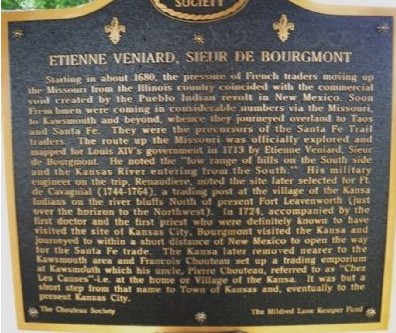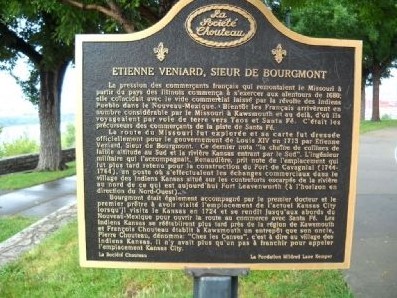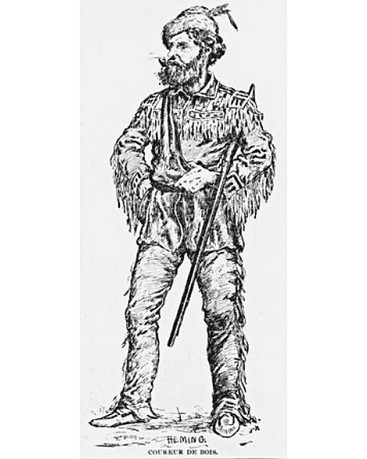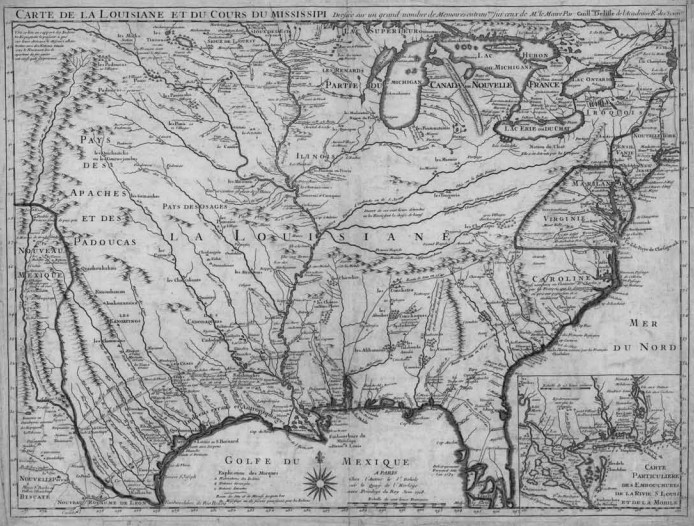Etienne Veniard - Sieur de Bourgemont Historical Marker
Introduction
Text-to-speech Audio
Étienne de Veniard, Sieur de Bourgmont was one of the most influential North American explorers of the first half of the eighteenth century. A former poacher and outlaw, he was the first man to officially chart the western Missouri territory for France. Bourgmont was well known for his close relationships with the Native American people groups in the Louisiana Territory and largely responsible for facilitating the 1725 Native American delegation to Paris. The location of this marker overlooks the Missouri River near the confluence of the Kansas River, where the Kaw tribe called home.
Images
English side of the marker, courtesy of Thomas Onions

French side of the marker, courtesy of Thomas Onions

An illustration of Étienne de Veniard, Sieur de Bourgmont

1718 map of the Louisiana territory, courtesy of the Library of Congress

Backstory and Context
Text-to-speech Audio
Étienne de Veniard, Sieur de Bourgmont was born to common means in central Normandy, France. At a young age he was convicted of poaching and fled to North America in 1699 to escape punishment. The ‘New World’ was well known in Europe at the time as a place people could go to escape old debts and problems. In America he was an avid frontiersman, working on and off as a trapper, trader, and soldier mainly around the Great Lakes in territories claimed by the French monarchy.
In 1706, Bourgmont returned to the outlaw life after he deserted his post as a soldier at Fort Pontchartrain near modern day Detroit. Being on the wrong side of the law did little to deter Bourgmont and he continued to trade and operate independently in the Louisiana Territory. He became well known for his competence as an outdoorsman and his connections with Native American groups. Due to his reputation, he was pardoned for his crimes in 1713 and began exploring and charting modern day Missouri and Kansas. Bourgmont lived with and grew very close to the Missouria who lived near the confluence of the Grand and Missouri rivers in modern day central Missouri. He eventually married the daughter of the Missouria’s leader. While he lived with them and traveled up and down the Missouri river he wrote heavily and documented many previously unrecorded aspects of the territory's geography.
Bourgmont’s written works proved to be so groundbreaking upon his return to Paris in 1720, that all past transgressions were forgotten, and Bourgmont was given command over the Missouri river and instructed to lead an expedition to build a fort along it. He decided to build it near where the Missouria people lived. It was known as Fort Orleans, and it was one of the westernmost multi-year settlement the French Crown ever had in North America. The end goal of Bourmont’s mission was to establish a safe trade route to Santa Fe by befriending as many local Native American groups as possible. Bourgmont found friends among the Plains nations easily, as they were eager to acquire European manufactured goods and horses from the French. One of these Nations to eagerly accept Bourgmont’s olive branch were the Kaw people who lived at the confluence of the Missouri and Kansas rivers, known as Kaw Point near modern day downtown Kansas City. Bourgmont made it to and past Kaw Point multiple times in his attempts to establish a trade route to Santa Fe, but he never fully completed this journey. In 1725 Bourgmont traveled back to Paris on a diplomatic mission with the leaders of the Native American groups he had befriended. He opted not to return with the Native American leaders, instead he married a French noblewoman and settled down in Normandy where he died in 1734.
The text of the marker reads as follows:
Starting about 1680, the pressure of French traders moving up the Missouri from the Illinois country coincided with the commercial void created by the Pueblo Indian revolt in New Mexico. Soon, Frenchmen were coming in considerable numbers via the Missouri, to Kawsmouth and beyond, whence they journeyed overland to Taos and Santa Fe. They were the precursors of the Santa Fe Trail traders. The route up the Missouri was officially explored and mapped for Louis XIV’s government in 1713 by Etienne Veniard, Sieur de Bourgmont. He noted the “low range of hills on the South side and the Kansas River entering from the South.” His military engineer on the trip, Renaudiere, noted the site later selected for Ft’ de Cavagnial (1744-1764), a trading post at the village of the Kansa Indians on the river bluffs North of present Fort Leavenworth (just over the horizon to the Northwest). In 1724, accompanied by the first doctor and the first priest who were definitely known to have visited the site of Kansas City, Bourgmont visited the Kansa and journeyed to within a short distance of New Mexico to open the way for the Santa Fe trade. The Kansa later removed nearer to the Kawsmouth area and Francois Chouteau set up a trading emporium at Kawsmouth which his uncle, Pierre Chouteau, referred to as “Chez Les Canses”-i.e. at the home or Village of the Kansa. It was but a short step from that name to Town of Kansas and, eventually to the present Kansas City.
Sources
Etienne Veniard - Sieur de Bourgemont, The Historical Marker Database. Accessed July 28th, 2022. https://www.hmdb.org/m.asp?m=86210.
Wright, Garrett . “To the Other Side of the Sun”: Indigenous Diplomacy and Power in the Midcontinent, kshs. Accessed August 5th, 2022. https://www.kshs.org/publicat/history/2018winter_wright.pdf.
Norall, Frank. Bourgmont: Explorer of the Missouri, 1698-1725. Alberta. The University of Alberta Press, 1988.
https://www.hmdb.org/m.asp?m=86210
https://www.hmdb.org/m.asp?m=86210
https://en.wikipedia.org/wiki/%C3%89tienne_de_Veniard,_Sieur_de_Bourgmont#/media/File:Coureur_de_bois.jpg
https://www.kshs.org/publicat/history/2018winter_wright.pdf
